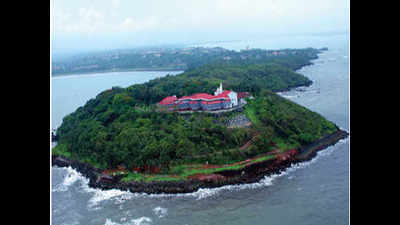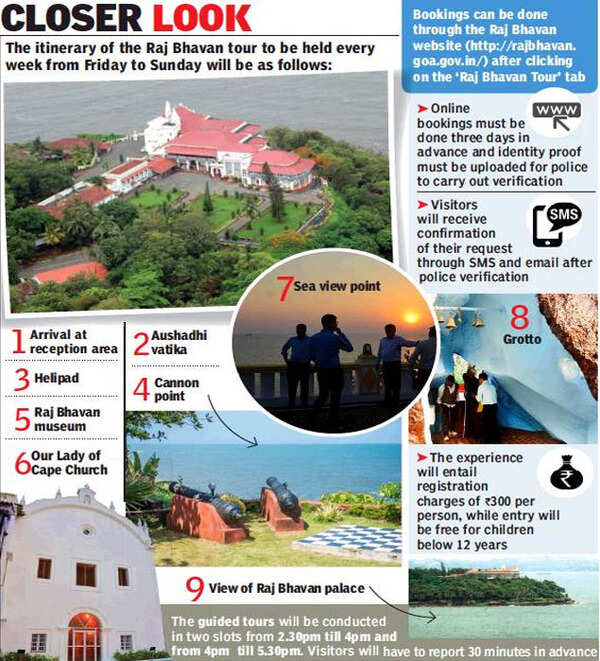Trending
This story is from January 5, 2019
A walk through Goa’s most iconic residence

Palacio do Cabo (File photo)
PANAJI: The 400-year-old Palacio do Cabo or Raj Bhavan, spread over 88 acres at the confluence of Goa’s two main rivers — the Mandovi and the Zuari — opened its doors to the public on Friday.
Earlier restricted to the governor and the governor’s guests, the Raj Bhavan will welcome guests thrice a week in a joint endeavor with Goa tourism development corporation (GTDC).
“This will give people, including tourists, a opportunity to see how the first citizen of Goa resides and explore the heritage and wealth of the place,” the governor’s secretary Rupesh Kumar Thakur said, adding it is one of the finest and oldest residences in the country.

Tourism minister Manohar Azgaonkar reminisced that he had to become a minister to be able to enter Raj Bhavan and said everyone should have the right to see it.
The Raj Bhavan has already received close to 40 bookings, GTDC managing director, Nikhil Desai said, appealing to travel trade tour operators to put across their marketing collaterals. “This must be on everyone’s itinerary,” he said.
Governor Mridula Sinha said the Raj Bhavan has received many suggestions on conducting tours, which will be taken up for consideration.
The tours will operate in two slots between 2:30 till 4 pm and 4 pm till 5:30 pm on Fridays, Saturdays and Sundays where visitors except children below the age of 12 will be charged Rs 300 for 90-minute tour.
Identification documents will have to be uploaded on the website following which police verification will take place. Visitors will be intimated about police verification outcome via email and sms and their photographs will be taken on entering Raj Bhavan.
Visitors will be taken on a guided tour to the medicinal herbarium ‘Aushadi Vatika’, the private helipad, the picturesque cannon point, the Raj Bhavan museum, the centuries old chapel of Nossa Senhora Mae de Deus, the grotto among other attractions.
The Raj Bhavan had recently approached the high court challenging the order of the state information commission which held that the governor’s house is a public authority and must appoint a public information officer. A social activist had filed a complaint with the commission stating that other Raj Bhavans in the country appointed a public information officer under the Right to information act, 2005.
Earlier restricted to the governor and the governor’s guests, the Raj Bhavan will welcome guests thrice a week in a joint endeavor with Goa tourism development corporation (GTDC).
“This will give people, including tourists, a opportunity to see how the first citizen of Goa resides and explore the heritage and wealth of the place,” the governor’s secretary Rupesh Kumar Thakur said, adding it is one of the finest and oldest residences in the country.

“Its grandeur and opulence is unmatched,” Thakur said, referring to the natural beauty and flora and fauna of the place.
Tourism minister Manohar Azgaonkar reminisced that he had to become a minister to be able to enter Raj Bhavan and said everyone should have the right to see it.
The Raj Bhavan has already received close to 40 bookings, GTDC managing director, Nikhil Desai said, appealing to travel trade tour operators to put across their marketing collaterals. “This must be on everyone’s itinerary,” he said.
Governor Mridula Sinha said the Raj Bhavan has received many suggestions on conducting tours, which will be taken up for consideration.
The tours will operate in two slots between 2:30 till 4 pm and 4 pm till 5:30 pm on Fridays, Saturdays and Sundays where visitors except children below the age of 12 will be charged Rs 300 for 90-minute tour.
Identification documents will have to be uploaded on the website following which police verification will take place. Visitors will be intimated about police verification outcome via email and sms and their photographs will be taken on entering Raj Bhavan.
Visitors will be taken on a guided tour to the medicinal herbarium ‘Aushadi Vatika’, the private helipad, the picturesque cannon point, the Raj Bhavan museum, the centuries old chapel of Nossa Senhora Mae de Deus, the grotto among other attractions.
The Raj Bhavan had recently approached the high court challenging the order of the state information commission which held that the governor’s house is a public authority and must appoint a public information officer. A social activist had filed a complaint with the commission stating that other Raj Bhavans in the country appointed a public information officer under the Right to information act, 2005.
End of Article
FOLLOW US ON SOCIAL MEDIA










